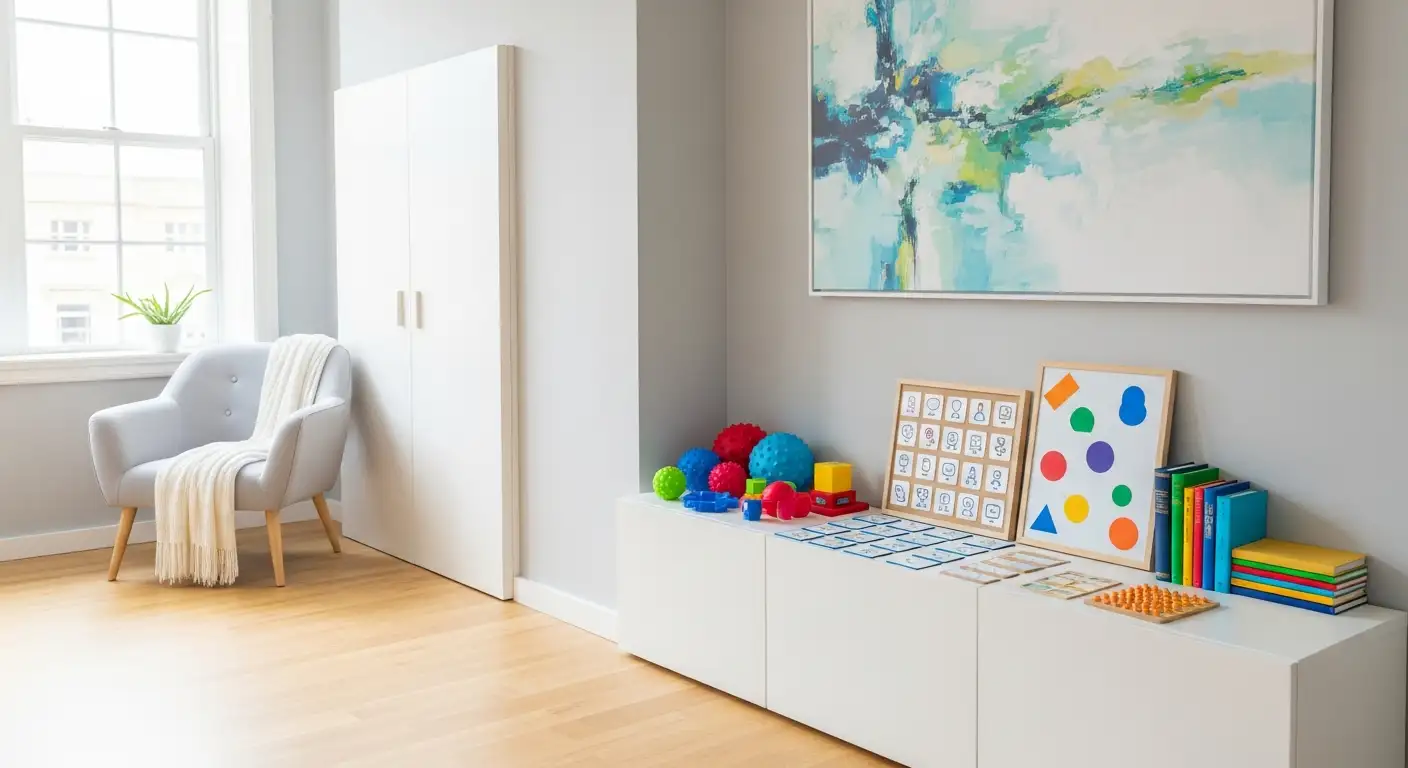Understanding and Implementing Calming Strategies for Autism
Children with autism often experience sensory overload and behavioral challenges that can lead to meltdowns and heightened stress. Implementing effective calming strategies is essential for supporting their emotional well-being, promoting self-regulation, and creating a safe, nurturing environment. This comprehensive guide explores various techniques, tools, and practical tips to help parents and caregivers manage and support children with autism effectively.
Understanding the Causes of Meltdowns and Behavioral Challenges in Autism

What are some effective calming strategies for children with autism?
Calming children with autism requires a variety of strategies tailored to their sensory needs and emotional states. Consistent routines and visual supports, such as visual schedules or calm-down corners, create a predictable environment that fosters security and reduces anxiety. Sensory tools like weighted blankets, calming tactile objects such as fidget toys, noise-canceling headphones, and sensory bottles filled with glitter or beads are highly effective in helping manage sensory overload.
Teaching relaxation techniques like deep breathing, mindfulness, grounding exercises, and body-based regulation behaviors such as stimming or jumping helps children develop self-calming skills. Recognizing early signs of stress, including behaviors like covering ears, withdrawal, or seeking sensory input, allows caregivers to intervene before a meltdown escalates.
Providing a safe and quiet space for the child, offering choices, and employing distraction techniques during stressful moments help them regain composure. These proactive measures help prevent meltdowns and build resilience over time.
How can understanding and supporting behavioral challenges improve outcomes for children with autism?
Understanding the underlying reasons for behavioral challenges allows caregivers and professionals to develop targeted strategies that address specific needs. Functional Behavior Assessment (FBA) is an essential tool for identifying the purpose or function behind a particular behavior, such as escape, attention, or sensory stimulation.
By analyzing triggers—like sensory overload, routine disruptions, or medical discomfort—caregivers can implement preventive measures. Visual supports, structured routines, and social stories help decrease anxiety and clarify expectations, reducing the likelihood of adverse behaviors.
Supporting communication skills through functional language development allows children to express their needs effectively, decreasing frustration that may lead to meltdowns. Positive reinforcement and consistent responses foster trust and cooperation.
When behavioral challenges are understood and addressed in a compassionate, individualized manner, children tend to display improved emotional regulation and social interactions. Over time, this leads to better developmental progress and enhances their overall quality of life.
| Aspect | Description | Example Strategies |
|---|---|---|
| Involuntary responses | Overload of sensory input triggers automatic reactions like meltdowns | Using sensory tools, deep pressure therapy, and calming environments |
| Recognizable triggers | Sensory overload, routine changes, medical issues | Behavior logs, create predictable routines, address sensory needs |
| Assessment tools | Identify functions of behaviors to guide intervention | Functional Behavior Assessment (FBA), behavior analysis reports |
| Calming techniques | Techniques that promote self-regulation during stress | Breathing exercises, sensory bottles, weighted blankets, visual supports |
| Preventive strategies | Actions to reduce likelihood of meltdowns | Visual schedules, social stories, organized sensory environments |
| Professional intervention | Support from therapists and specialists | Occupational therapy, behavior therapy, medication if needed |
By integrating these approaches, caregivers can create a supportive environment that recognizes early warning signs of distress, implements timely calming methods, and addresses the root causes of behavioral challenges. This holistic approach fosters growth, independence, and emotional well-being for children with autism.
Implementing Routine and Visual Supports for Consistency

Why is maintaining structured routines important for children with autism?
For children with autism, consistent routines help create a sense of stability and predictability. When daily activities follow a familiar pattern, it reduces feelings of uncertainty, which can often trigger anxiety or stress. Knowing what to expect gives children a sense of control over their environment, making it easier for them to manage overwhelming situations.
Structured routines also assist in developing independence by encouraging children to follow sequential steps in daily tasks. This predictability can lead to fewer meltdowns and more positive behaviors, as children feel safer and more secure.
How do visual supports like schedules and timers aid in routine management?
Visual supports are essential tools that help children understand and anticipate upcoming activities. Visual schedules, consisting of pictures or symbols representing daily tasks, serve as clear, tangible cues indicating what is happening next. These schedules can be posted at eye level or used in individual activity charts, making transitions smoother.
Timers and visual countdowns further reinforce timing, helping children prepare for changes or the end of activities. When children see visual timers, they are less likely to feel anxious about transitions, as they understand when a current activity will conclude. This fosters patience and compliance.
How does creating a predictable environment foster security and independence?
Designing a consistent, sensory-friendly environment supports children in feeling more secure and confident in their surroundings. Organized spaces with designated areas for different activities minimize overstimulation and confusion.
In addition, visual supports like labeled bins, routine charts, and visual timers contribute to self-reliance. When children learn to reference these tools, they gain skills to manage their day and navigate social situations more effectively.
By combining predictable routines with visual cues, caregivers lay the foundation for emotional stability and facilitate the child's development toward independence.
Practical tips for parents and caregivers
| Tip | Description | How it helps |
|---|---|---|
| Establish consistent routines | Keep daily activities and schedules steady | Reduces anxiety and behavioral issues |
| Use visual schedules and timers | Incorporate images, symbols, and visual countdowns | Enhances understanding and transition management |
| Create a sensory-friendly environment | Organize spaces with calming decor, lighting, and sound control | Supports focus and emotional regulation |
| Incorporate sensory breaks | Regularly scheduled breaks with sensory tools | Prevents overload and meltdowns |
| Seek professional guidance | Consult occupational therapists for personalized support | Tailors strategies to the child's unique needs |
By integrating these practices, caregivers foster an environment that promotes security, independence, and overall well-being for children with autism.
How do visual supports help in autism routine management?
Visual supports include schedules, timers, social stories, and visual cues that make daily routines more comprehensible. Research shows these tools significantly decrease anxiety and improve behavioral outcomes by providing clarity and predictability.
Using visual supports consistently helps children develop self-regulation skills, understand expectations, and transition between activities more smoothly.
For further insights, searching “visual supports autism routine management” can provide additional strategies and resources to implement effective routines tailored to each child's needs.
Sensory Tools and Activities to Promote Calmness
 Children with autism often experience sensory overload, which can lead to distress or meltdowns. To help manage this, a variety of sensory tools and activities have been shown to promote calmness and improve regulation.
Children with autism often experience sensory overload, which can lead to distress or meltdowns. To help manage this, a variety of sensory tools and activities have been shown to promote calmness and improve regulation.
One effective approach involves sensory objects such as weighted blankets, sensory bottles, and calming lighting. Weighted blankets provide gentle, deep pressure that can soothe the nervous system, promoting relaxation. Sensory bottles filled with glitter or liquid serve as visual calming tools—they help redirect attention and reduce overstimulation. Calming lighting, such as soft, dim lights or colorful lamps, can create a soothing environment that alleviates sensory stress.
Movement-based activities are also essential for sensory regulation. Swinging, jumping, or bouncing on therapy balls help children burn off excess energy and integrate sensory input effectively. Activities like wall pushes, trampoline jumping, crawling through tunnels, or obstacle courses are engaging ways to provide proprioceptive input—this helps children feel grounded and secure.
Tactile stimulation is another crucial component. Textured toys such as fidget spinners, stress balls, Tangle toys, and sensory brushes provide tactile input that helps children focus and regulate emotions. Oral sensory items like chew toys can also be beneficial, especially for children who seek oral stimulation.
Creating a designated sensory corner filled with these tools encourages children to self-regulate during overwhelming moments. Occupational therapists often recommend personalized sensory diets that incorporate these tools and activities tailored to each child's preferences and sensitivities.
| Sensory Tool or Activity | Purpose/Benefit | Example or Description |
|---|---|---|
| Weighted blankets | Provide calming deep pressure | Soothe anxiety, promote relaxation |
| Sensory bottles | Visual focus and distraction | Glitter or liquid-filled bottles |
| Calming lighting | Reduce visual overstimulation | Soft LED lamps or colored lights |
| Swinging and jumping | Regulate proprioceptive input | Swing sets, jumping on trampoline |
| Textured toys | Provide tactile sensory input | Fidget spinners, Tangle toys |
| Oral sensory items | Support oral stimulation | Chewable necklaces, chew toys |
| Movement activities | Engage large muscles | Wall pushes, obstacle courses |
| Sensory corner | Safe space for regulation | Area with sensory tools and calming decor |
Using these tools and activities, often in consultation with occupational therapists, can significantly improve a child’s ability to manage sensory overload. Tailoring interventions to individual preferences enhances their effectiveness and supports emotional regulation.
Calming Activities and Therapeutic Interventions

What calming activities are effective for children with autism?
Calming activities are essential for helping children with autism relax when they are overstimulated or anxious. These activities are particularly useful before or after stimulating events, or whenever the child shows signs of restlessness. Examples include rocking on a therapy ball, creating a dark or quiet space, swinging (facing an adult to avoid spinning), and wrapping in heavy blankets, which provides deep pressure.
Other effective techniques involve using sensory tools like sensory fidgets or applying gentle, calming touch such as brushing arms or head. Listening to relaxation music, performing deep pressure squeezes, or rolling a ball over the child's body can also soothe sensory overload. Visual calming tools like sensory bottles filled with glitter or liquid serve as visual focal points to help redirect focus.
Creating a comfortable environment with calming lighting and using gentle massage or downward strokes along the spine can further reduce anxiety. Additionally, the use of sensory objects like weighted vests or blankets provides calming input, promoting relaxation through deep pressure therapy.
How can exercise and movement help children with autism?
Physical activity plays a significant role in calming children with autism by helping them burn off excess energy. Moving around, such as running, jumping, or using resistance exercises like therapy bands, can improve physical focus and emotional regulation.
Incorporating structured routines like yoga, which combines deep breathing, grounding, and meditation, can bring long-term benefits when practiced regularly. Yoga and similar exercises help children develop self-awareness, manage stress, and improve mood.
Engaging in obstacle courses or resistance activities such as wheelbarrow walking or crawling through tunnels stimulates the senses actively and can be a fun way to promote calmness. Regular movement also enhances overall well-being, reduces anxiety, and helps manage hyperactivity.
| Activity Type | Example Exercises | Benefits | Additional Notes |
|---|---|---|---|
| Deep pressure | Weighted blankets, vests, body squeezes | Promotes relaxation | Can be used during calming routines |
| Body-based regulation | Stimming, jumping, swinging | Helps process sensory input | Should be tailored to individual preferences |
| Physical activity | Yoga, obstacle courses, resistance exercises | Improve mood, focus, and reduce stress | Should be incorporated into daily routines |
Using these calming and physical activities, supported by personalized strategies and environmental adjustments, can significantly improve emotional regulation in children with autism. Consulting with occupational therapists can help develop an effective sensory diet tailored to each child's needs.
Environmental Modifications for a Calming Setting

How can creating sensory-friendly environments help children with autism?
A sensory-friendly environment aims to reduce overstimulation and provide a safe, comfortable space for children with autism. Organized spaces with minimal clutter and overstimulating stimuli help children feel more secure, making it easier to manage sensory overload. Incorporating calming lighting, such as soft or dim lights, along with soothing visual decor like calming posters or gentle colors, can promote relaxation. Managing noise levels through soundproofing or the use of white noise and noise-canceling headphones further minimizes auditory overstimulation.
What sensory tools and activities can help children with autism regulate their sensory overload?
A variety of sensory tools and activities are effective in helping children with autism self-regulate during overwhelming moments. Sensory tools like weighted blankets, lap pads, inflatable chairs, and compression vests deliver calming input through deep pressure. Tactile toys such as fidget spinners, stress balls, and textured objects provide tactile stimulation that reduces anxiety and energetic restlessness. Noise-canceling headphones, sensory bottles filled with glitter or beads, and calming lighting offer visual and auditory soothing options.
Engaging in movement-based activities like swinging, jumping on trampolines, or crawling through tunnels can help burn excess energy and support sensory integration. Other calming activities, such as rolling a therapy ball over the body, light massage, or body wraps, foster relaxation. Creating a dedicated sensory space or quiet corner equipped with preferred sensory items encourages children to self-soothe when overwhelmed.
Why is providing a safe and quiet sanctuary important?
A designated calming area functions as a refuge where children can retreat during moments of sensory overload. Such spaces should be equipped with various sensory tools, soft lighting, and calming decor to promote relaxation. Having a consistent safe space helps children anticipate and manage overstimulating situations, reducing anxiety and decreasing the likelihood of meltdowns. Caregivers are encouraged to support children in using this space as part of a structured approach to sensory regulation.
How does environmental adjustment support emotional regulation?
Adjustments like organizing sensory-friendly zones help children better regulate their emotions by minimizing triggers. When sensory input is controlled and predictable, children experience less anxiety. Visual supports such as schedules, timers, and social stories complement the environment by providing predictability and a clear understanding of daily routines. Overall, an organized, low-stimulation setting creates a foundation for children with autism to remain calm, cope better with stress, and develop positive behaviors.
The Role of Therapeutic and Professional Support
 Understanding and managing meltdowns in autism involves more than immediate calming techniques; it also requires professional evaluation and tailored intervention strategies.
Understanding and managing meltdowns in autism involves more than immediate calming techniques; it also requires professional evaluation and tailored intervention strategies.
Engaging therapists, behavior specialists, and occupational therapists is essential for developing an effective support plan. These experts can assess the child's unique sensory and behavioral profile, often using tools like the Functional Behavior Assessment (FBA). An FBA helps identify the specific triggers and functions behind meltdowns, guiding targeted interventions.
Incorporating both physical and behavioral therapies can provide comprehensive support. Physical approaches, like sensory integration therapy, address sensory processing challenges through activities such as heavy work exercises or calming sensory tools. Behavioral therapies, including Applied Behavior Analysis (ABA), focus on reinforcing positive behaviors and replacing challenging behaviors with functional communication.
Utilizing assessments like FBA allows caregivers and professionals to understand the root causes of behaviors. This understanding prompts personalized strategies, such as visual schedules, social stories, or environmental modifications, that can reduce triggers and build coping skills.
Overall, a collaborative approach involving assessments and tailored therapies can improve emotional regulation, communication, and social skills. Such support helps children navigate their environment more comfortably, reducing the frequency and intensity of meltdowns, and fostering overall developmental progress.
| Support Type | Purpose | Techniques |
|---|---|---|
| Behavioral Therapy | Identify behavior functions and teach replacement skills | ABA, social stories, visual supports |
| Physical Therapy | Improve sensory integration and regulation | Sensory activities, heavy work, weighted objects |
| Professional Assessments | Understand sensory and behavioral challenges | FBA, sensory profiles, occupational evaluations |
By integrating professional insights, children with autism can develop effective strategies to handle their sensory and emotional challenges more successfully.
Moving Forward with Calm and Confidence
Supporting children with autism through effective calming strategies enhances their ability to manage sensory overload and behavioral challenges. By creating a predictable environment, integrating sensory tools, and employing calming activities, caregivers can significantly reduce stress and meltdowns. Professional support from therapists and behavior specialists complements these approaches, ensuring tailored interventions that promote emotional regulation and developmental progress. With patience, consistency, and compassion, families can foster a sense of safety and calm that empowers children to thrive and navigate the world with confidence.
References
- Meltdowns & Calming Techniques in Autism
- 7 Calming Strategies for Autism Every Parent or Guardian ...
- 10 Calming Strategies for Autism: Reduce Anxiety and ...
- How to Help Calm a Child Living with Autism
- 25 Organising and Calming Sensory Activities For Children ...
- Ten simple sensory strategies for autistic children
- 24 Classroom Activities for Kids with Autism
- Using sensory regulation strategies to help your child














